 Open Access Article
Open Access ArticleStudy and application status of the nonthermal effects of microwaves in chemistry and materials science – a brief review
Nannan Wang *a,
Wenhui Zoub,
Xinyue Lia,
Yaqi Lianga and
Peng Wang*b
*a,
Wenhui Zoub,
Xinyue Lia,
Yaqi Lianga and
Peng Wang*b
aDepartment of Environmental Engineering, Beijing Institute of Petrochemical Technology, Beijing 102617, PR China. E-mail: wnn_flying@163.com; Tel: +86-13704517275
bSchool of Environment, State Key Laboratory of Urban Water Resource and Environment, Harbin Institute of Technology, Harbin 150090, PR China. E-mail: pwang73@hit.edu.cn
First published on 9th June 2022
Abstract
Microwaves (MWs) are widely known and used in human life and production activities based on their thermal effects. In contrast, their nonthermal effects are still under debate. Fortunately, the nonthermal effects of MWs have been investigated by an increasing number of researchers and have shown great potential in industrial production. In this review, typical studies that demonstrate the nonthermal effects of MWs in chemistry and materials science are introduced and discussed, and the applications of and the harms that are caused by these effects are summarized to facilitate the safe use of these MW effects. The mechanisms of the nonthermal effects of MWs that have been proposed by researchers with various backgrounds are presented. Because some researchers did not detect nonthermal effects of MWs, four typical relevant studies are identified and introduced. Various types of MW reactors (single-mode and multimode reactors and reactors without a MW cavity) are summarized and compared. Finally, possible directions for future research on the nonthermal effects of MWs are proposed.
Introduction
Microwaves (MWs) are a part of the electromagnetic spectrum, and their frequency range is from 0.3 GHz to 300 GHz, which corresponds to a wavelength range of 1 m–1 mm.1 In commercial applications, the allowed MW frequencies are 2.45 and 0.915 GHz, which correspond to wavelengths of 122 and 328 mm, respectively. These frequencies must be used to avoid interference with military applications.2 MWs were used initially in 1937, and a MW oven that operated at 2.45 GHz was produced in 1947.3 Due to their unique heating features including fast heating speed, excellent heating uniformity, easy control of heating and selective absorption, MWs are traditionally applied to heat substances, and the heating capacity of MW heating has been proven to be much higher than that of conventional heating (CH).In the early study of MWs researchers focused on the thermal effect of MWs. MWs heating belongs to internal heating, and its thermal effect is reflected through the interaction mechanism with polar molecules including dipole rotation and ion conduction, resulting in a series of phenomena including overheating effect, hot spot effect, selective heating and elimination effect.4 With the increasing understanding of MWs, researchers with various professional backgrounds identified phenomena that could not be explained by the thermal effects of MW irradiation.5 These phenomena were called nonthermal effects by these researchers.6 Specifically, MWs non-thermal effect refers to other effects except thermal effect, such as electric effect, magnetic effect and chemical effect. The nonthermal effect is considered to be the direct coupling of MWs to the internal energy of the molecules rather than conversion to heat energy which can be interpreted as the coupling of the electric field with specific (polar) molecules in the reaction medium.4 Since then, the possibility of nonthermal effects has been tested in various chemical and materials science, such as the Maillard reaction, mutagenesis of bacteria, protein denaturation and polymer solubility.7
Researchers who identified nonthermal effects of MWs always based their conclusions on experimental results that were derived from experimental phenomena within their own fields of study. According to previous studies,8–10 such effects can change the physicochemical properties of systems while the temperature and all other parameters are controlled precisely.
The studies were conducted by researchers from diverse fields (such as activity studies of various enzymes and cells,11,12 a solution polycondensation study,13 a treatment study of microbial agents,14 a study of photoassisted reactions,15 a phase change study,16 and studies of the physicochemical properties of media),17–19 and these researchers may have lacked professional knowledge of other fields; consequently, they could not effectively communicate regarding the nonthermal effects, thereby hindering the discussion and identification of a universal mechanism that can explain all or most of the experimental phenomena. Notably, not all researchers detected nonthermal effects of MWs. Thus, the controversy regarding whether MWs have nonthermal effects has continued until now.
Researchers believe that the existence of non-thermal effects can be judged by whether MWs electromagnetic fields can induce random collisions of reactant molecules and thus induce self-organization. Opponents argue that MWs are often associated with higher temperature and are too weak to cause molecular self-organizing behaviour, while proponents argue that open systems far from equilibrium can self-organize due to the exchange of matter and energy. In order to solve the dispute, two aspects must be improved: (1) standard experimental conditions and equipment; (2) strict experimental means and methods, especially fine measurement of temperature spatial distribution under MW irradiation.20
In this review, we summarize the studies that detect nonthermal effects of MWs, propose an operating mechanism for these effects, and introduce the applications of and the harms that are caused by these effects based on published reports from various fields. After that, arguments against the existence of nonthermal effects of MWs are reviewed. In addition, the types of MW reactors that are used in various fields are summarized, classified and compared. Finally, directions for future investigation of the nonthermal effects of MWs are proposed.
Evidence of nonthermal effects of MWs
The researchers who advocate for the existence of nonthermal effects of MWs always make their claims by comparing experimental phenomena that are caused by MW heating and CH. According to previous studies, the nonthermal effects of MW can be reflected in various aspects, such as (1) variations in solution conductivity, (2) variations in substance microstructure, (3) variations in the composition and nutritional quality of food, and (4) the generation of H2O2 in water and physiological solutions. Typical studies are summarized in Table 1, and some typical figures are given as well.| No. | Research contents | Experimental conditions | Experimental results | Ref. | ||||
|---|---|---|---|---|---|---|---|---|
| Frequency | Power | Time | Others | |||||
| 1 | Changing the conductivity of solutions | Effects of MW irradiation on the resistance of dimethyl sulfoxide (DMSO)-NaCl solution. | 5.8 GHz | 25 W | — | (1) The intensity of MW irradiation is on the order of 104 V m−1; | (1) Using CH, the resistances of DMSO-NaCl solution decreased with increasing temperature; | Tian et al.21 |
| (2) The solution flows at 15 m s−1 to remove the thermal energy from the process of MW irradiation. | (2) Using MW irradiation, the resistances of DMSO-NaCl solution increased with increasing temperature. | |||||||
| 2 | Effects of MW irradiation on the resistance of NaCl solution. | 2.45 GHz | — | — | The intensity of the electrical fields/magnetic fields is 3.4 × 104 V m−1. | This study has the same experimental results as that in no. 1 in this table. | Tian et al.22 | |
| 3 | Effects of MW irradiation on the electrical resistance of NaCl solution. | 2.45 GHz | 400 W | — | (1) The electric field magnitude is on the order of 104 V m−1; | The result that “the lower the temperature is, the more obvious the electrical conductivity (EC) change” indicated the existence of nonthermal effects of MWs. | Huang et al.17 | |
| (2) the maximum value in the solution is 3.488 × 104 V m−1. | ||||||||
| 4 | Changing the microstructure of substances | Polycondensation of L-lactic acid | 2.45 GHz | 300 W | 6 h | (1) Xylene was used as solvent to maintain the reaction temperature at the boiling point (142 °C). This excluded the effect of temperature. | (1) At the same temperature, the molecular weight of poly (L-lactic acid) that was obtained using MW irradiation was greater than that of poly that was obtained using CH, thereby indicating the existence of the nonthermal effects of MWs. | Yamada et al.13 |
| (2) Catalysts such as Sc(OTf)3 and SnCl2 were used in the polycondensation of L-lactic acid. | (2) An electric field can accelerate the polycondensation reaction, while a magnetic field can inhibit polycondensation or accelerate degradation, or both, thereby indicating the existence of nonthermal effects of MWs because no difference in the heating behaviour of the reaction system was observed. | |||||||
| 5 | MW-induced unfolding of proteins | 2.45 GHz | — | — | The temperature that can induce the onset of strong binding to the chaperone = 63 °C. | Compared with CH, the unfolding of citrate synthase (CS) occurs at significantly lower temperatures and the degree of unfolding is significantly higher under MW irradiation, thereby indicating the existence of nonthermal effects of MWs. | George et al.23 | |
| 6 | 2.45 GHz | 700 W | — | Immunoglobulin was chosen as the index in this experiment. | MW irradiation can dramatically shorten the enzyme-linked immunosorbent assay duration from 18 h to <5 min under the exclusion of the thermal effects of MWs. This proved the existence of nonthermal effects of MWs. | Ahirwar et al.24 | ||
| 7 | Sintering of tailing-based glass-ceramics | 2.45 GHz | 2000 W | — | (1) In CH, a uniform heating rate of 12 °C min−1 was applied for 60 min to reach 720 °C. | MW irradiation can reduce the crystallization activation energy from 375.7 kJ mol−1 to 214.9 kJ mol−1, accelerate the grain growth during crystallization, enhance the formation of the diopside crystal structure, and improve the physicochemical properties of the final materials. Above results prove the existence of nonthermal effects of MWs. | Li et al.25 | |
| (2) In MW heating, the samples were subjected to MW irradiation for 90 min at 2 kW with a measured temperature of 820 °C and no holding time. | ||||||||
| 8 | Sintering of ceramics | 2.45 GHz | 1200 W | Changes with sintering temperature from 1 to 7 days | (1) The electrophoretic deposition technique was used to prepare the specimen to reduce the possible influence of sample preparation on the pore structure. | Mean pore aspect ratios differed significantly in the presence of MWs and increased with increasing sintering temperature in MW fields. This accords with the theory of ponderomotive driving forces, which can explain the nonthermal effects of MWs. | Link et al.26 | |
| (2) The specimen was processed within adequate thermal insulation to avoid temperature gradients. | ||||||||
| (3) T = 1230–1300 °C. | ||||||||
| 9 | Decrystallization of silicon | 2.45 GHz | 1200 W | 5 min | Maximum temperature = 850–1000 °C. | (1) A single-crystal silicon wafer that was exposed to MW underwent strong decrystallization, while the part that was covered by a metal coating remained as a single crystal. | Nozariasbmarz et al.27 | |
| (2) Decrystallization occurred in the bulk of the material, in addition to on the surface. | ||||||||
| ●The above two results indicate the existence of nonthermal effects. | ||||||||
| 10 | Changing the nature of food | Heating of food (ground beef meat) | 2.35–2.55 GHz | 800 W | 1.5 min | (1) A set of meat samples were inserted into a conventional electric oven, which had been preheated to the temperature of 175 °C; | (1) In CH, the intensity of the carbonyl band at 1742 cm−1 and the methylene group bands at 2921 and 2853 cm−1 can be increased. In MW heating, the increases in intensity of these bands were smaller; hence, the temperature in ground beef meat samples under MW irradiation was lower than that in samples that were subjected to CH. | Calabro et al.28 |
| (2) Another set of meat samples were inserted into a domestic MW oven, with two peaks at approximately 2.44 and 2.48 GHz. The integrated value of the power density in the range of 2.35–2.55 GHz amounted to 217 mW m−2. | (2) MW heating can significantly increase the intensity of the amide I, II, and III regions, namely, from 1660 to 1675 cm−1 and at approximately 1695, 1635, 1575, and 988 cm−1. | |||||||
| 11 | Formation of H2O2 in solution | 160 GHz | 5.83 mW cm−2 | 10 min | Vdistilled water = Vphysiological solution = 0.5 mL; the distance between the antenna and the surface of exposed distilled water or physiological solution samples was 1–2 mm. | The MW nonthermal effects can promote the dissociation of water molecules by promoting the vibration of dipoles of water molecules and further promoting the generation of H2O2. | Ayrapetyan et al.18 | |
Changes in the resistance of electrolyte solutions
According to the results in no. 1 and 2, the resistances of DMSO-NaCl and NaCl solutions can increase with increasing temperature during MW irradiation, but the opposite was observed during CH (Fig. 1). The researchers in these two studies obtained the same experimental result with different electrolyte solutions. The researchers in no. 3 conducted a similar experiment to those in no. 1, but they analysed the nonthermal effects of MWs from different angles. According to a previous study,29 more significant variations in EC should be observed at higher temperatures under MW irradiation. However, the experimental results were the inverse of this, namely, the lower the temperature was, the larger the EC changes were. This was obviously caused not by the thermal effects of MWs but by the nonthermal effects.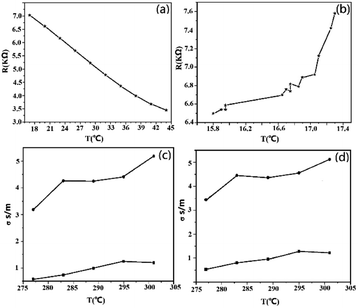 | ||
| Fig. 1 Change of resistance of solution by CH (a), and by MW irradiation (b);21 change of electrical conductivities of solution by CH (c) and by MW irradiation (d).22 | ||
Changes in the microstructures of substances
Studies on the variation of substance microstructures focus on various aspects. We retrieved the relevant work and examined the nonthermal effects of MWs from three aspects.Promoting the polycondensation of substances
As presented in no. 4 in Table 1, under multimode MW irradiation, Yamada et al.13 obtained poly(L-lactic acid) with a higher molecular weight than that obtained under the CH mode in the solution polycondensation of L-lactic acid (Fig. 2(a)). In addition, they found that under single-mode MW irradiation, an electric field can accelerate the polycondensation reaction, while a magnetic field can inhibit polycondensation or accelerate degradation, or both. As the two experiments were conducted at the same temperature, the effect of temperature was excluded. Thus, the different experimental results support the existence of nonthermal effects of MWs.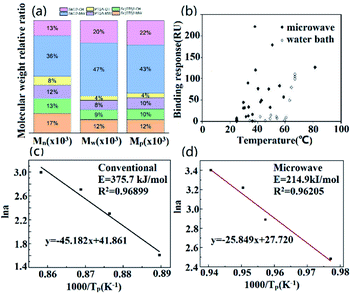 | ||
| Fig. 2 The comparison of solution polycondensation of L-LA between catalyzed by different catalysts and heated at conventional temperature (a);13 the difference in binding of CS toa-crystallin minus binding to a control surface versus final temperature (b);23 the relation between crystallization activation energy and temperature during CH (c) and MW heating (d).25 | ||
Inducing the unfolding of proteins
As presented in no. 5 in Table 1, George et al.23 observed that CS underwent a significantly higher degree of unfolding under MW exposure than under CH when the experimental temperature was maintained at the same maximum value (Fig. 2(b)). In addition, the unfolding of CS occurred at significantly lower temperatures when MW irradiation was used. As the thermal effect was excluded, the study supported the hypothesis that MWs have nonthermal effects on protein conformation.The results of the above experiments were supported by Ahirwar et al.24 (no. 6). They claimed that biopolymers that have many polar functional groups try to align themselves with the orientation of the MW field that is used and that this behaviour gives rise to the unfolding of the protein. In addition, they found that MW can significantly shorten the enzyme-linked immunosorbent assay duration from 18 h (CH) to 4 min 40 s (MW heating). As MW thermal effects were excluded in this experiment, the authors attributed this phenomenon to the nonthermal effects of MWs. An interesting and reasonable postulation of Ahirwar et al. is that MWs can be considered a new type of catalyst, namely, the nonthermal effects of MWs could be MW catalytic effects.24
Promoting the crystallization and decrystallization of substances
As presented in no. 7 in Table 1, Li et al.25 proved the existence of nonthermal effects of MW irradiation based on the advantages of MW irradiation in comparison with CH in the processing of ceramics. They applied gold and iron tailings to produce glass-ceramics under MW irradiation. They found that MW irradiation can substantially enhance the microstructural uniformity and significantly reduce the crystallization activation energy compared to CH (Fig. 2(c) and d).In addition, MW irradiation can affect the crystal orientation, induce changes in the Si–O bond lengths and Si–O–Si angles, and further enhance the formation of the diopside crystal structure. The samples that were prepared using MW irradiation exhibited superior physicochemical performance.
As presented in no. 8 in Table 1, Link et al.26 proved the existence of nonthermal effects of MW irradiation from the second angle, namely, the effects of MW irradiation on the pore structure evolution of ceramics. They found that a linearly polarized MW field can give rise to nonisotropic pore closure in the MW sintering process of zirconia ceramics, namely, with increasing sintering temperature, the mean aspect ratio of all pores is greater than 1. This phenomenon agrees with ponderomotive driving force theory, which can be used to support the nonthermal effects of MWs.
MWs can also show nonthermal effects in the decrystallization of substances. As presented in no. 9 in Table 1, Nozariasbmarz et al.27 found that the part of a single crystal silicon wafer that was exposed to MW irradiation showed strong decrystallization while the part that was covered by a metal coating remained in its original state. Additionally, the decrystallization process occurred in the bulk of the single crystal silicon wafer, not on the surface. As the two parts of the single crystal silicon wafer were subjected to the same experimental conditions, the above observations support the existence of nonthermal effects of MWs.
Changes in the composition and nutritional quality of food
As presented in no. 10, Calabrò et al.28 observed nonthermal effects of MWs in the cooking of food by MW heating. They found from spectral analyses that ground beef meat that was heated by CH showed increases in the intensities of the carbonyl band (1742 cm−1) and the methylene group bands (2921 and 2853 cm−1). This was attributed to the Maillard reaction. However, the increases in the intensities of these bands by MW heating were smaller, thereby demonstrating that the temperature in the ground beef meat samples that were subjected to MW heating was less than that in those that were subjected to CH (Fig. 3). In addition, MW heating can give rise to significant increases in the intensities of the amide I, II, and III regions from 1660 to 1675 cm−1 and in the intensities at approximately 1695, 1635, 1575, and 988 cm−1. This result highlights the nonthermal effects of MWs on the secondary structures of proteins.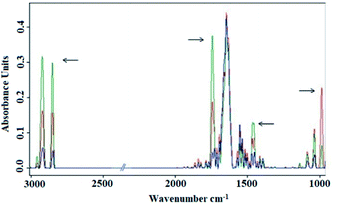 | ||
| Fig. 3 Representative FTIR spectra in the range 3000–970 cm−1 of ground beef meat. Blue, green, and red lines refer to raw ground beef, ground beef cooked in a conventional oven, and ground beef cooked in a MW oven, respectively.28 | ||
Generation of H2O2 in water and a physiological solution
As presented in no. 11 in Table 1, Ayrapetyan et al.18 found that low-intensity MW irradiation could increase the concentration of H2O2 in distilled water and a snail physiological solution by promoting the vibration of dipoles of water molecules (Fig. 4). Specifically, the concentrations of H2O2 in distilled water and the snail physiological solution were increased by 10 min MW irradiation from 2.78 to 2.88 nmol L−1 (distilled water) and from 3.03 to 3.24 nmol L−1 (the snail physiological solution). As the intensity of MWs was very low (5.83 mW cm−2), the thermal effects of MWs could be ignored, thereby supporting the existence of nonthermal effects of MWs.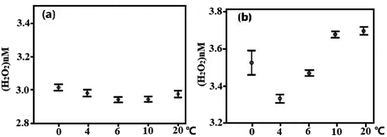 | ||
| Fig. 4 The concentration of H2O2 in distilled water (a) and physiological solution (b) at different temperature.18 | ||
Mechanisms of the nonthermal effects of MWs
Researchers have proposed mechanisms for the nonthermal effects of MWs. They can be roughly divided into six categories.Theory of causing vibration of molecules and varying dielectric constant of substance
The theory of causing vibration of molecules explains the significant effect of MWs on the chemical reaction. The non-thermal effects of MWs have a certain polarization effect on molecules and atoms, resulting in the situation that the molecular dipole moment is not equal to zero. The molecular vibration may cause the resonance of the chemical bond, even break it,30 and subsequently the chemical properties of substance could be changed. In the study of the non-thermal effects of MWs on biological function of organism, Zuo et al.31 found that the energy provided by MWs can cause thermal motion collision of water molecules, thus generating more hydrogen bonds between water molecules. As a result, the solubility, permeability, diffusion and emulsification of the water were enhanced, which can “activating” the metabolism and lipid metabolism immune function. Davey et al.32 found that protein and DNA can form hydrogen bridges through hydrogen bonds to maintain the spatial configuration of protein DNA.The nonthermal effects of MWs can also vary dielectric constant of substance. Zhou et al.33 simulated the molecular dynamics of DMSO-ethanol mixture under MW irradiation, and found that MWs could affect the dielectric properties of the solvent, enhance the intermolecular forces, change the arrangement dynamics of hydrogen bonds, and prolong the life of hydrogen bonds. In the phenomenon of MW resonance dielectric effect associated with ferromagnetic resonance, Chen et al.34 found that with the gradual increase of Yb3+ doping amount, the non-thermal effects of MWs can cause Yb-YIG lattice shrinkage, reduce the electric dipole of Fe2+–Fe3+, and eventually lead to the weakening of MWs magnetic dielectric effect.
Theory of nonthermal phonon distributions of MWs
The MW field could excite nonthermal phonon distributions to enhance ion mobility and diffusion rates, which appears to be possible through the following mechanisms: (1) the production of localized resonant coupling by weak bond surface modes or point defect modes, (2) zero-frequency mode coupling that requires localized concentrations of charge imbalance, and (3) three-wave mixing that involves either two closely spaced MW frequencies and one low-frequency elastic wave, or two high-frequency elastic waves and one MW frequency electromagnetic wave. John H. Booske et al.35 used the highly simplified linear oscillator lattice model to prove the theory of nonthermal phonon distributions. Model simulation results suggested that MW nonthermal effects occur mostly in polycrystalline forms and at elevated bulk temperatures. Moreover, the mechanism of nonthermal effects in polycrystalline forms is usually described by mechanisms (2) and (3), which is consistent with reported ceramic sintering experimental observations.36 The probabilities for mechanisms (2) and (3) are enhanced at higher temperatures. This theory is often used to explain various MW accelerated solid sintering phenomena and other MW processing phenomena.Classical harmonic oscillator theory
Classical harmonic oscillator theory is reflected in the use of coherent, polarized and resonant (CPR) MW irradiation. During irradiation, the “resonance-enhanced” energy input to the irradiated material may become enormous, thereby remarkably increasing the free energy and, thus, promoting isothermal reactivity. In the processing of various materials, CPR MW irradiation produces nonthermal effects, such as reaction feasibility promotion and process kinetics enhancement, which is based on this theory. Various nonthermal effects have been applied in the materials industry in developing innovative processes and novel products.37,38 B. Wong39 described the mechanism as a well-controlled, sequential, uniform energy transfer between an MW-irradiated dielectric system and its surroundings at a specified temperature in material processing.Theory of averaged ponderomotive action of MWs
The theory of averaged ponderomotive action of MWs suggests nonthermal effects of high-frequency electromagnetic fields (including MW fields) on charge and mass transport in solids. This theory is always used to explain the nonthermal effects of MWs in material processing, such as high-temperature ceramic processing, where MWs can enhance the process kinetics by reducing either the temperature or the time that is necessary to complete the process.40–42 Rybakov et al.43 confirmed this theory by investigating the dynamics of MW-induced quasistationary ionic currents in AgCl and NaCl. Agreement between experiment and theory provides strong evidence for the validity of the averaged ponderomotive action of MWs.Theory of the interaction between electric fields and specific (polar) molecules
The theory of the interaction between electric fields and specific (polar) molecules was reflected in food processing. This result suggested that MWs exert nonthermal effects through this interaction that cause changes in the composition of a substance for the effective treatment of food.44,45 M. Antonia Herrero et al.46 proposed the theory to describe MW nonthermal effects after reevaluating four synthetic transformations (Diels–Alder cycloaddition, alkylation of triphenylphosphine and 1,2,4-triazole, and direct amide bond formation) under both MW dielectric heating and CH.The application of MWs in cell inactivation also reflected the theory of the interaction of electric fields with specific molecules. Priyanka Shaw et al.47 found in a study of the inactivation of bacterial cells by MW irradiation that MWs can interact with molecules on the surfaces of bacterial cells, thereby causing changes in cell morphology and further leading to failure of the intracellular oxidative defence machinery and DNA damage-mediated inactivation of bacterial cells.
Theory of decreasing activation energy
The activation energy is an important kinetic parameter for evaluating a reaction process, and the nonthermal effects of MWs usually reduce the activation energy and increase the reaction rate. In an experiment on organic wastewater waste-activated sludge (WAS) hydrolysis, I. G. Byun et al. proposed that MW nonthermal effects caused a reduction in the activation energy of the reaction. Therefore, compared with the CH effect of sludge hydrolysis, the MW treatment rate was higher and the time that was needed was shorter.48 This mechanism is also reflected in the degradation processes of other types of organic matter.49,50Applications of and harms that are caused by the nonthermal effects of MWs
The application of MWs has a long history.51 Due to its nonthermal effects, MW irradiation has shown remarkable advantages and extra functions compared with CH; hence, the nonthermal effects of MWs have been applied in various special scenarios. In addition, the harms that are caused by the nonthermal effects of MWs have also attracted researchers' attention, as the identification of these harms is beneficial for reducing harm from MW irradiation.Applications of the nonthermal effects of MWs
In this section, typical applications of the nonthermal effects of MWs are presented in Table 2. The application fields of the nonthermal effects of MWs include, according to our summary, environmental governance, industrial production, and medical treatment. In addition, the nonthermal effects of MWs can be applied in the energy field.| No. | Application scenarios | Specific application | External expression of the nonthermal effects of MWs | Data that support the performance | Ref. |
|---|---|---|---|---|---|
| 1 | Environmental governance | The advanced treatment of organic wastewater | The nonthermal effects can improve the degradation rate of N-nitrosodimethylamine (NDMA) that is sorbed in zeolites, compared with CH. | MWs can produce hot spots, and the apparent activation energy is 18.2 kJ mol−1, which is much lower than those of common thermolysis reactions. | Hu et al.49 |
| 2 | The coupling of MWs to an ultraviolet light (UV) light source can be used in the treatment of environment pollutants. | The MW nonthermal effects can enhance the TiO2 photoassisted reactions. | The relevant dynamics of the break-up of the bisphenol A (BPA) phenyl rings in the integrated MW-/photo-assisted method in the presence of TiO2 particulates system shows that the cleavage of the rings is twofold faster than that in the photo-assisted method alone (3.3 × 10−4 mmol L−1 min−1 versus 1.7 × 10−4 mmol L−1 min−1). | Horikoshi et al.53 | |
| 3 | For P25 titania, the number of ·OH that were produced by the UV/MW method was nearly 30% greater than the number that were generated by the UV method alone. A fivefold increase in incident MW power from 3 to 16 W caused a non-insignificant increase (ca. 40%) in the number of ·OH radicals that were produced. | Horikoshi et al.15 | |||
| 4 | The hydrolysis of WAS | The MW nonthermal effects can reduce Ea and improve the hydrolysis rate of WAS. | The Ea values of WAS hydrolysis by MWs were much lower than that of CH (22.6–31.0% of that of CH). | Byun et al.48 | |
| 5 | Industrial production | Improvement of the fermentation activity of Saccharomyces cerevisiae | The MW nonthermal effects can significantly decrease the fermentation time. | The sample that was treated by MW had a lower sugar content, its fermentation time was reduced by 40% and its fermentation capacity increased by approximately 30%. | Kapcsandi et al.54 |
| 6 | Degumming of hemp | The MW nonthermal effects can accelerate the degumming process of hemp. | The corresponding carbon and oxygen atomic concentration ratios gradually increased from 0.35 for untreated hemp to 0.49 for the MW-treated fibre. | Tian et al.55 | |
| 7 | Production of high green densities and homogeneous pore size distribution ceramics | The MW nonthermal effects can increase the sintered densities significantly. | At the maximum sintered densities, MW-sintered tetragonal zirconia had nearly half the grain sizes as conventionally sintered tetragonal zirconia. | Mitsudo et al.56 and Link et al.57 | |
| 8 | Production of crosslinked gelatine with higher turbidity, crosslinking degree, and viscosity | The MW nonthermal effects can accelerate the crosslinking reaction of gelatine. | MW heating with simultaneous cooling increased the turbidity, crosslinking degree, and viscosity of the crosslinked gelatine by 91 FTU, 6.8%, and 0.08, respectively and endowed it with a higher molecular weight as the grey levels decreased by 9.2% (235–245 kDa), 2.3% (135–145 kDa), and 9.3% (122–132 kDa). | Wu et al.58 | |
| 9 | Production of GO with low wettability. | The MW nonthermal effects can decrease the wettability of GO. | MWs can cause the water uptake capability of GO to decrease by half and the contact angle of water droplets to increase from ∼29.7° to ∼69.9°. | Rasuli et al.59 | |
| 10 | Production of α-alumina with high densification | The MW nonthermal effects can strengthen the sintering by increasing the intensity of densification. | The final densities are 99.88% and 99.40% during MW and conventional sintering, respectively, at a heating rate of 25 °C min−1. | Zuo et al.60 | |
| 11 | Medical treatment | Clarification of the mechanisms of adjuvant treatment for delayed and nonunion fractures. | The MW nonthermal effects can reduce the NaCl solution viscosity by rotating dipolar water molecules to make high-frequency alterations to hydrogen bonds. | The time that was required to reduce the initial resistance of the solution by 10% was 1.7 times shorter with MWs. | Hinrikus et al.52 |
| 12 | Promotion of the bioactivity of LDH | The MW nonthermal effects influence protein functions through changes in the bioactivity of LDH. | (1) The biological activity of the LDH enzyme can be increased by 40–70% using low-power MWs at 500 MHz to 30 dBm, 500 MHz to 40 dBm, and 500 MHz to 50 dBm, and the maximum increase is achieved at 900 MHz-30 dBm; | Pirogova et al.10 | |
| (2) The biological activity of the LDH enzyme can be reduced by 2–15% using high-power MWs at 650 MHz to 30 dBm, 700 MHz to 40 dBm, and 750 MHz to 50 dBm. | |||||
| 13 | Energy exploration (biomass) | Hydrolysis of cellulose to sugar | The MW nonthermal effects have high efficiency in the hydrolysis of cellulose compared with CH. | Under 135 W of MW irradiation, the conversion of cellulose exceeded 69.1% and the yield of the total reducing sugar reached 56.0% at 5 min of hydrolysis. | Zhai et al.61 |
| 14 | Pretreatment of lignocellulosic biomass | The MW nonthermal effects can be used to pretreat lignocellulosic to change its biomass. | The MW can dissolve 10% of the hemicellulose in corn stalks in a pressurized reactor. | Bichot et al.62 |
According to the above statement, MWs can also be used in special but important scenarios in addition to CH. However, their wide application in these scenarios requires additional time. Thus, acceleration of the study of the nonthermal effects of MWs is of urgent necessity because these effects may provide substantial benefits to humans.
Harms that are caused by the nonthermal effects of MWs
With the wide use of MWs, living beings on the planet always receive MW irradiation. Harms that are caused by the nonthermal effects of MWs have been identified by researchers.63 Although relatively few studies have been conducted on the harms that are caused by the nonthermal effects of MWs, we can still obtain useful information that can provide a reference and support in Table 3 for the exploration of protection technology and relevant legislation.| No. | Study content | Specific harm caused by the nonthermal effects of MWs | Data that can support the reported harm | Ref. |
|---|---|---|---|---|
| 1 | Harm to animal cell | Influence the process of cell division and cell cycle. | The mitotic index of V79 cells exposed to the power density of 10 mW cm−2 (29.20 ± 6.02‰) differed significantly from the mitotic index of control cells (44.38 ± 8.69‰). | Ballardin et al.66 |
| 2 | Harm to human health | (1) Increases the risk of brain cancer; | There is a significant increased risk for glioma and the meta-analysis yielded an odds ratio (OR) = 1.90[95% confidence interval (CI) = 1.31–2.76]. For ipsilateral mobile phone use the risk increased further to OR = 2.54 (95% CI = 1.83–3.52) in the meta-analysis based on 247 exposed cases and 202 controls. | Belpomme et al.65 |
| (2) has adverse effects on reproduction. | ||||
| 3 | Influence heart muscle function. | Intraperitoneal injection of nonthermal MW–treated physiological solution (PS) not only had elevation effect on inracellular contents of cAMP (38%) and depression effect on cGMP contents in heart muscle (12%), but also had more pronounced effect on heart muscle hydration (4.7%) than the injection of Sham-treated PS. | Narinyan et al.68 | |
| 4 | Induce the HeLa cell to apoptosis. | The apoptotic effect induced by dielectric barrier discharge is 7%, whereas by 7 μmol L−1 nitric oxide-plasma activated water is 18% in 4 minutes. | Li et al.69 | |
| 5 | Cause mood disorders and increase anxiety. | The T3 went from 100.2 to 78.8, T4 went from 1.24 to 3.01 while TSH only had slight change in modulated MWs of 2450 MHz chronic exposure. | Sinha et al.67 | |
| 6 | Damage lens tissues and lens epithelial cells. | Exposure in 2450 MHz MWs for 8 h at a power density of 5 mW cm−2 resulted in obvious opacity in the lens cortex; exposure in 2.22 mW cm−2 MWs at 1.1 GHz caused a reversible decrease in lens optical quality and irreversible morphological and biochemical damage to the LEC layer. | Yu et al.64 |
Regarding harm to the human body, Yu et al.64 reported that exposure to low-power MWs (such as in the use of radiofrequency devices) can affect lens transparency, alter cell proliferation and apoptosis, inhibit gap junctional intercellular communication, and induce genetic instability and stress responses in lens epithelial cells. Belpomme et al.65 found that diseases are induced when human beings are exposed to 3 Hz–300 GHz (MWs are included because the MW frequency range is 300 MHz–300 GHz), such as various cancers, Alzheimer's disease, and hypofertility.
Regarding harm towards animals, Ballardin et al.66 evaluated the influence of the nonthermal effects of MWs on spindle assembly, mitotic cells and the viability of Chinese hamster V-79 cells, and they found that MW irradiation at the water resonance frequency can induce alterations of the mitotic apparatus and even apoptosis on the premise of the exclusion of thermal effects. This experimental result confirmed the strong influence of the nonthermal effects of MWs on the activity of animal cells. Sinha et al.67 studied the influence of the nonthermal effects of MWs on electroencephalogram (EEG) of rats that were chronically exposed to MW irradiation. Sleep- EEG, open field behaviour, and thyroid hormones (T3, T4, and Thyroid stimulating hormone (TSH)) were analysed, and the authors observed significant changes in all examined pathophysiological parameters except body temperature, grooming behaviour, and TSH levels.
According to the above studies, it is indisputable that the nonthermal effects of MWs can cause harm to animals, including humans. Nonthermal MWs should only be applied with adequate protective measures.
Typical cases that do not support the existence of nonthermal effects
Various researchers did not observe nonthermal effects of MWs in their experiments, and there is no convincing theory/mechanism to support the existence of nonthermal effects of MWs; hence, these researchers remain sceptical. They believe that, according to their experimental results, the nonthermal effects of MWs were caused by the difficulty of precisely controlling the experimental conditions. Four typical cases are examined in this review, and Table 4 presents necessary information on these cases to help readers understand the corresponding studies easily.| No. | Study contents | Experimental control | Results | Ref. | ||
|---|---|---|---|---|---|---|
| Experimental conditions | Analysis paths of nonthermal effects of MWs | Measurement method that can exclude the thermal effects of MWs | ||||
| 1 | Effects of MW irradiation on the production of the Maillard reaction products in the MW sterilization of growth media. | Two 150 mL mixtures, namely, “0.5 mol L−1 glucose plus 0.5 mol L−1 lysine” and A. actinomycetemcomitans growth medium, were heated in 3 modes: (1) water-bath heating on a hot plate; | Comparison of the inhibition effects on the generation of Maillard reaction products of MW irradiation with a water bath. | Volume adjustment control in MW irradiation was used to avoid the effects of reactant concentration on the detection of the nonthermal effects of MWs. | The phenomenon that the generation rate of Maillard reaction products is ∼20 times faster in MW heating than in a water-bath heating is caused by the increase of the reactant concentration but not the nonthermal effects of MWs. | Bhattacharjee et al.70 |
| (2 and 3) MW irradiation with/without volume adjustment. Timers were started when the solutions started to boil. | ||||||
| 2 | Effects of MW irradiation on human cell proliferation and activity. | (1) Normal human skin fibroblast and human glioblastoma cells were irradiated by MWs of 70–300 GHz in 1.0 GHz steps, 10 μW. | Comparison of the cell proliferation, cell activity and cytotoxicity under MW irradiation and water-bath heating, respectively. | The MW power was controlled at a low level (10 μW), at which the thermal effects can be negligible. | No difference was observed in cellular proliferation, activity or toxicity between MW-exposed cells and unexposed cells. | Yaekashiwa et al.11 |
| (2) Exposure time = 3, 70, and 94 h. | ||||||
| 3 | Effects of MW irradiation on the inactivation of wheat germ lipase | Five groups of experiments were conducted with various experimental conditions. Consider group 1 as an example: (1) Vwheat germ lipase = 5 mL; | Comparison of the conformation and activity of wheat germ lipase that was treated by MW irradiation and CH. | A cooling system with a cooling medium that was MW transparent was used to maintain the target temperature under the coordination of a fibre optical probe that could detect the exact temperature. | (1) At 20 °C, the conformation and activity of wheat germ lipase did not change in either heating mode. | Chen et al.12 |
| (2) T = 20 °C; | (2) At 45 and 60 °C, the inactivation efficiency of MW irradiation was approximately 10% higher than that of CH, but this was caused by the thermal effects of MWs based on the analysis results. | |||||
| (3) PMW = 10–80 W; | ||||||
| (4) Irradiation time = 900 s. | ||||||
| Readers can find more details in the cited paper. | ||||||
| 4 | Effects of MW irradiation on multiple test aspects, including Maillard reaction, protein denaturation, polymer solubility, mutagenesis of bacteria, mutarotation equilibrium of a/b-D-glucose, and saturation solubility of NaCl. | ■ General experimental conditions: (1) MW frequency = 2.45 GHz; | For the study “formation of Maillard reaction products”, the authors heated the tested solutions in a similar manner, using both MW irradiation and CH. | The temperature and other parameters were kept constant, and the same procedure was used. | No nonthermal effects were detected in any of the tested systems. | Shazman et al.71 |
| (2) MW specific power = 1000 W kg−1; | For the other tested system, readers can find more details in the cited paper. | |||||
| (3) Irradiation time = 48 h. | ||||||
| ■ specific experimental conditions--consider “formation of Maillard reaction products” as an example: (1) Vglucose solution = 200 mL; | ||||||
| (2) Vglycine solution = 50 mL; | ||||||
| (3) flow rate = 400 mL min−1; | ||||||
| (4) PMW = 31 W 250 mL−1 solution. | ||||||
| Readers can find more details in the cited paper. | ||||||
Case 1: production of maillard reaction products in the MW sterilization of growth media
MW irradiation has an inactivation effect on microorganisms. In a study of the MW sterilization of growth media (Fig. 5), Bhattacharjee and Delsol70 found that the production rate of the Maillard reaction products in the MW-treated samples was 20 times faster than that in the water bath-treated samples (no. 1). However, the analysis, which was based on the experimental data, shows that this effect was caused by the rapid increases in the concentrations of the reactants under MW irradiation (water in aqueous solutions was lost at a high rate since MWs can heat solutions extremely rapidly) compared with those in the CH mode, namely, the thermal effects of MWs played a critical role in the production of the Maillard reaction products, and no nonthermal effects of MWs were detected.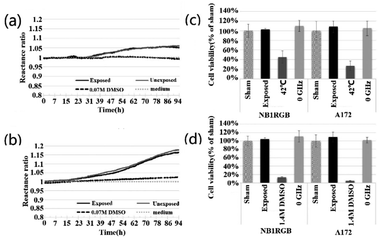 | ||
| Fig. 5 Formation of Maillard reaction products. Solution of glucose and lysine heated using MW (bottom X-axis) without volume adjustment (solid diamonds) and with volume adjustment (squares) or using a hotplate (triangles, top X-axis). A460 values for each shown on the left Y-axis. Reactant concentrations shown only for MW heating without volume adjustment (open diamonds, right Y-axis).70 | ||
Case 2: proliferation and activity of human cells under low-power MW irradiation
MW irradiation may affect the proliferation and activity of cells. Yaekashiwa et al.11 investigated the nonthermal effects of long-term MW irradiation (3, 70, or 94 h) on the proliferation and activity of human cells (normal human skin fibroblasts and human glioblastoma cells). They avoided the thermal effects of MWs by using low-power MWs (10 μW) and positioning the MW source underneath the cells. They found no nonthermal effects of MWs after comparing the cellular proliferation, activity and toxicity of the exposed cells and the unexposed cells (no. 2 and Fig. 6).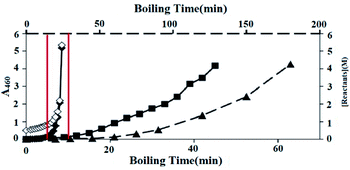 | ||
| Fig. 6 Normal human skin fibroblast cell proliferation curve (a); human glioblastoma cell proliferation curve (b); activity of normal human skin fibroblast and human glioblastoma cells (c); and cytotoxicity assay results (d).11 | ||
Case 3: inactivation of wheat germ lipase under MW irradiation
Both MW irradiation and CH can inactivate enzymes. However, whether the inactivation behaviours under MW irradiation are caused by nonthermal effects has yet to be determined definitively. Chen et al.12 found no variation in the conformation or activity of wheat germ lipase at 20 °C under MW irradiation in comparison with CH. In addition, they observed a change in structure and a decrease in activity at 45 and 60 °C, and the efficiency of MW irradiation in the inactivation of wheat germ lipase was approximately 10% greater than that of CH (Fig. 7). However, this was caused by the thermal effects of MWs according to the analysis results (no. 3).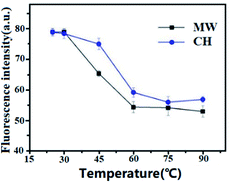 | ||
| Fig. 7 The relation of fluorescence intensity (λex = 279 nm) and temperature of the WGL treated by MW and CH.12 | ||
Case 4: MW effects in multiple tested systems
The above three cases examined the nonthermal effects of MWs from various aspects. In this case, the authors71 tested the nonthermal effects of MWs simultaneously from six aspects, namely, Maillard reaction (Fig. 8(a) and (b)), protein denaturation (Fig. 8(c)), polymer solubility (Fig. 8(d)), mutagenesis of bacteria (Fig. 8(e) and (f)), mutarotation equilibrium of a/b-D-glucose (Fig. 8(g), (h) and (i)), and saturation solubility of NaCl (Fig. 8(j)). However, they did not find any evidence of nonthermal effects of MWs (no. 4).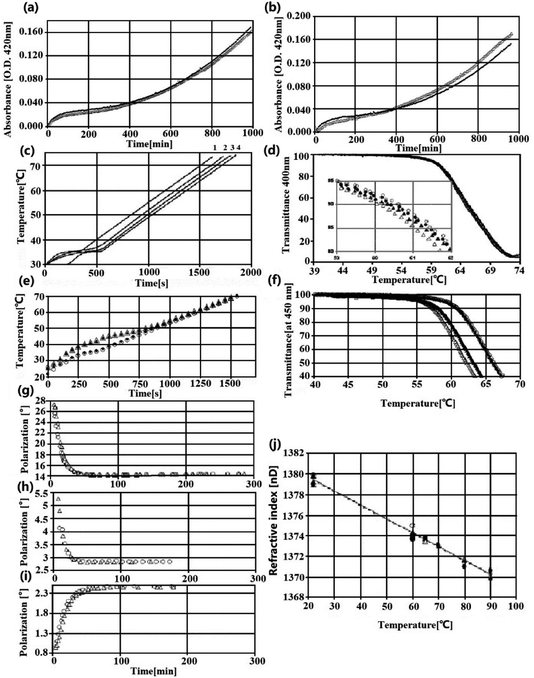 | ||
| Fig. 8 (a and b) Development of Maillard reaction pigment products; (c) heating profile of egg white protein in a CaCl2 solution [lines 1 and 4: MW heating; lines 2 and 3: oil bath]; (d) turbidity development during heating of egg white solution in CaCl2; (e and f) the result of the effect of time–temperature profile on protein denaturation; (g, h and i) mutarotation of a or b-D glucose solutions during MW or bath heating [g: 0.74 mol L−1 a-D-glucose, h: 0.139 mol L−1 a-D-glucose, i: 0.125 mol L−1 b-D-glucose]; (j) equilibrium refractive index of saturated NaCl water solution maintained at different temperatures by either MW or bath heating [MW(●, ○), bath(▲, △)].71 | ||
In the experiments in the above cases, nonthermal effects of MWs were not observed. Shazman et al.71 believed that the differences in experimental conditions may have affected the test results. We think that the test system and the precise control of the experimental conditions may both play critical roles in the testing of the nonthermal effects of MWs. Different test systems and rough control would introduce large experimental errors that may hide the nonthermal effects of MWs.
Typical MW reactors in the study of the nonthermal effects of MWs
MW reactors can provide a space where the MW field and material field can interact with each other. The MW reactor that is used in the experiment may affect the experimental results and even affect the detection of the nonthermal effects of MWs. According to the characteristics of the MW waveform distribution, an MW reactor can be divided into two parts, namely, a multimode MW reactor and a single-mode MW reactor, where multimode means that there are many kinds of MW distribution forms in a resonant space, which results in defects in heating uniformity and repeatability, while single-mode means that there is only one MW distribution in the MW reactor, which can easily achieve uniform heating and repeatability. In addition, a special MW reactor that does not need an MW cavity was also used in the study of the nonthermal effects of MWs.Importantly, each type of MW reactor has a different structure. The diversity of forms of MW reactors determines the generalized influence of MW effects in many application and research fields. Thus, understanding the typical types of MW reactors is beneficial for further exploration of the MW nonthermal effect mechanism.
Single-mode MW reactors
Single-mode MW reactors can be roughly divided into three kinds according to the type of MW cavity, namely, reactors with annular, corridor-like, and advanced corridor-like MW cavities.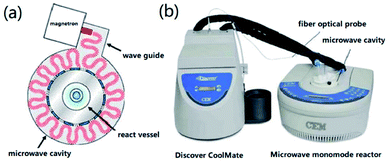 | ||
| Fig. 9 Schematic diagram (a) and photograph (b) of the annular single-mode MW reactor.12 | ||
As shown in Fig. 9, the reaction solution was placed in a sealed reaction vessel and stirred, and the reaction vessel was clamped on top in the centre of the cavity, where MW irradiation could be equally accepted. With the switching on of MW irradiation, the single-mode MW reactor focused the MW beam on the samples.
An infrared temperature probe and a pressure monitoring sensor were equipped in the MW reactor to control the processing temperature, while a cooling system that was MW transparent had to be equipped simultaneously. To collect the precise reaction temperature in the reaction vessel, a fibre optical probe was also needed to detect the temperature of the reaction system.
A typical single-mode MW reactor with a corridor-like MW cavity is illustrated in Fig. 10. Yamada et al.13 used this equipment to realize the solution polycondensation of L-lactic acid under the nonthermal effects of MWs.
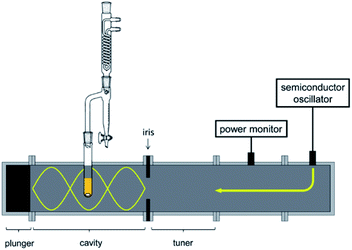 | ||
| Fig. 10 Schematic diagram of the corridor-like single-mode MW reactor.13 | ||
As illustrated in Fig. 10, the single-mode MW cavity has critical structures, which include a plunger, cavity iris, tuner, power monitor and semiconductor oscillator. In this MW cavity, a standing wave that composed of MWs can be formed. As MWs can be divided into an electric field and a magnetic field that are shifted by 1/4 of a wavelength from each other, the electric field and magnetic field can be distinguished by choosing the position of the reaction vessel, thereby enabling the study of the electric field and magnetic field, respectively. Importantly, the MW power is the difference between the input power and the reflex power.
Fig. 10 illustrates the internal structure of the single-mode MW reactor, while Fig. 11 shows the typical external structure and corresponding equipment. Kang et al.14 applied this reactor to study the thermal and nonthermal germicidal effects of MW irradiation on microbial agents. In this reactor, after the MW beam reaches the waveguide applicator, it is reflected and eliminated by the isolator. Incident waves and reflected waves were used to monitor power. The temperature variation in the reacting vessel was monitored with an optical fibre thermometer.
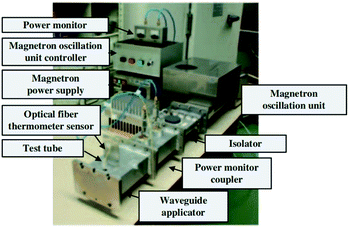 | ||
| Fig. 11 Photograph of the corridor-like single-mode MW reactor.14 | ||
A single-mode MW reactor can integrate with other physical fields, such as the photofield. A typical single-mode corridor-like MW reactor with the integration of a photoreactor is shown in Fig. 12. Horikoshi et al.15 used this equipment to study the influence of the MW nonthermal effects on titania photoassisted reactions. As shown in Fig. 12(b), UV light can be easily introduced into the reacting vessel by a light guide.
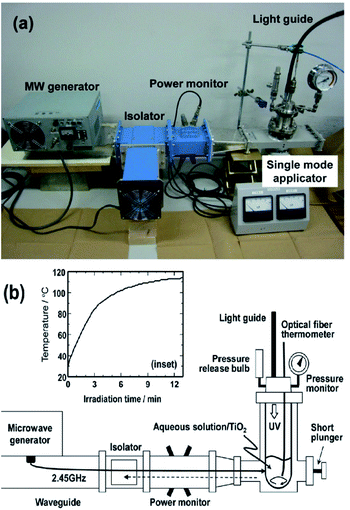 | ||
| Fig. 12 Photograph (a) and schematic diagram (b) of an integrated MW/photoreactor system with a corridor-like single-mode MW reactor.15 | ||
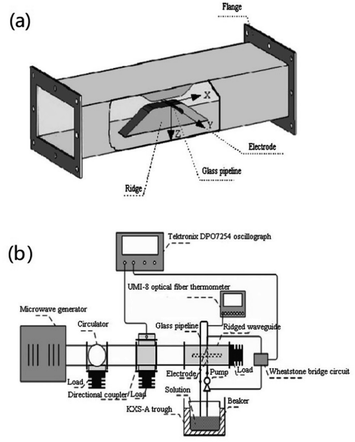 | ||
| Fig. 13 Internal construction of the ridged waveguide with a glass pipeline (a) and the whole experimental system (b).17 | ||
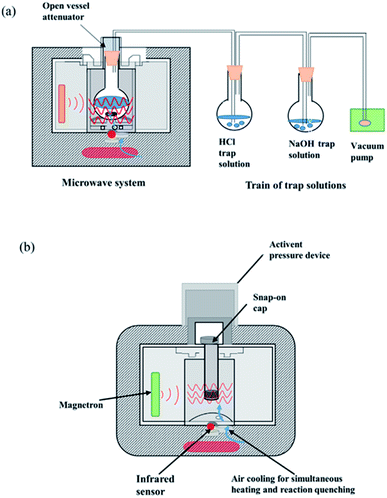 | ||
| Fig. 14 Schematic diagram of the single-mode test cavity with CH.16 | ||
Multi-mode MW reactors
A multimode MW cavity is a large and spacious cavity that differs obviously from a single-mode cavity. Some reactors can be designed in various versions according to the requirements of the experiment and can realize various functions. In addition, reactors can be introduced into and controlled easily in such a large cavity.Hu et al.49 used both an open vessel and a closed vessel with MW irradiation to study the MW-induced degradation of NDMA that is adsorbed in zeolites under the nonthermal effects of MWs. As illustrated in Fig. 15(a), to avoid the leakage of MWs from the open system, an open vessel MW attenuator must be used to confine the MWs inside the cavity. In addition, the steam that is formed by MW irradiation must be discharged by a glass pipeline and collected by a solution; as illustrated in Fig. 15(b), as the reaction vessel is closed by a snap-on cap with a Teflon liner, the pressure and temperature must be controlled by the corresponding technologies.
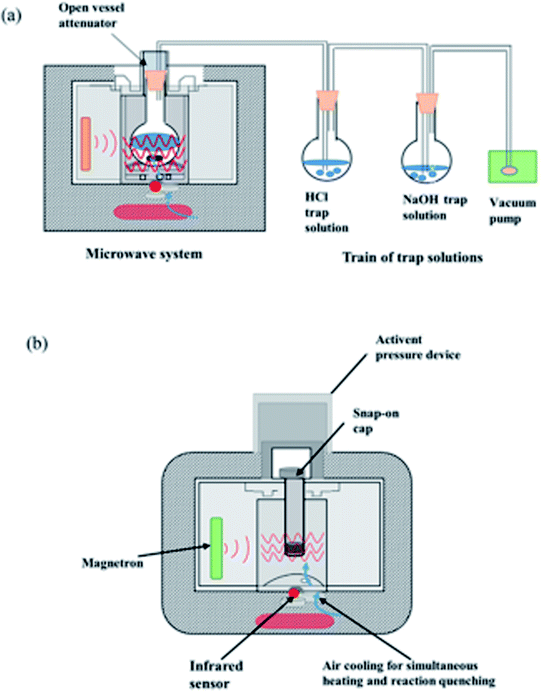 | ||
| Fig. 15 Schematic diagrams of multimode test cavities with (a) open-vessel irradiation of the sample (an MW attenuator was used to confine the MW irradiation inside the cavity) and (b) closed-vessel irradiation of the sample (the pressure and temperature in the reaction vessel were controlled within a reasonable range).49 | ||
A multimode MW irradiation system can integrate easily with other physical fields, such as photoirradiation. As shown in Fig. 16, an open vessel with multimode MW irradiation was applied by Horikoshi et al.53 This system differs from that in Fig. 15 in its use of an extra photoirradiation system. A light source was introduced into the reactor by a light guide from the top of the reactor. Horikoshi et al.53 used this integrated reactor to reassess the nonthermal effects of MWs by the degradation of BPA under MW photoassistance in an aqueous TiO2 dispersion.
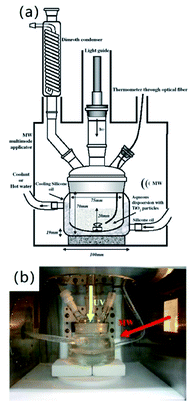 | ||
| Fig. 16 Schematic diagram (a) and photograph (b) of the multimode MW-assisted photoreactor.53 | ||
In a multimode MW reactor, auxiliary equipment may be required, such as temperature and pressure detection systems, mixing systems, and cooling systems with refrigerants that are transparent to MWs (such as silicone oil and air).49,53 These systems should be designed to not interfere with MW irradiation.
A single-mode MW reactor can be controlled precisely and can be used in experiments and small-scale industrial production, but its high manufacturing cost, high maintenance cost, and high operation cost limit its wide application. The accuracy of a multimode MW reactor can never compare with that of a single-mode MW reactor, thereby resulting in poor repeatability. However, a multimode MW reactor can be used when accurate control is not needed, such as in wastewater treatment. Its remarkable advantages are low manufacturing cost and mature use experience.
Direct weak-intensity MW irradiation system without an MW cavity
Special study systems that differ from normal single-mode and multimode MW irradiation systems can be used as well. These systems can make the MWs directly contact the tested medium without the use of an MW cavity.Ayrapetyan et al.18 studied the effects of the nonthermal effects of weak-intensity MW irradiation on various physicochemical properties (specific EC, specific heat capacity, heat fusion and melting kinetics after freezing in liquid N2, and free radical formation) of water and water solutions. As illustrated in Fig. 17, an MW generator (Artsakh-04 M, which was produced by ‘‘Rikta-Center’’ limited liability company in Russia) that is always applied in clinical treatments was used directly to irradiate a medium using the head of its dielectric antenna. The distance between the head of the dielectric antenna of the MW generator and the surface of the medium was only 1–2 mm. This kind of irradiation avoids the spread of MWs in the cavity and unnecessary power loss.
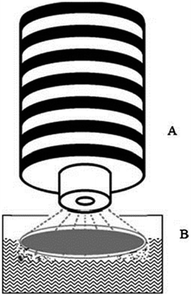 | ||
| Fig. 17 Schematic diagram of weak-intensity MW irradiation without an MW cavity. ((A), head of the dielectric antenna of the MW generator; (B), exposed water sample).18 | ||
Yaekashiwa et al.11 studied the nonthermal effects of weak-intensity MW irradiation by investigating the variations in the proliferation, activity, and cytotoxicity of normal human skin fibroblasts and human glioblastoma cells. As shown in Fig. 18(a), the measurement of cell proliferation can be realized by focusing MWs on one cell. To irradiate a single well, the light-source head was placed inside an aluminium pipe of 100 mm length and set under the well; as shown in Fig. 18(b), the activity and cytotoxicity of cell can be measured by irradiating the whole 96-well plate (Corning, 3596, USA) with the MW source 100 mm under the plate's bottom surface.
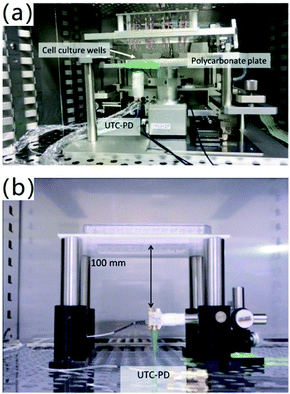 | ||
| Fig. 18 Photographs of weak-intensity exposure apparatuses that were used to evaluate the MW nonthermal effect. (a) Was used for cell proliferation measurement. (b) Was used for cell activity and cytotoxicity measurement.11 | ||
Comparison of the types of MW reactors
According to the above discussion on the types of MW reactors, we find that the MW cavity is not necessary for studying the nonthermal effects of MW irradiation. However, we cannot remove the MW cavity casually because MW irradiation is harmful to human health; we can do this only if the MW intensity is controlled within an extremely low level and the tested medium can accept MW energy directly. In addition, accessories may be needed for various functions, such as monitoring and controlling the temperature and pressure, adjusting the MW cavity space, and adding an extra physical field, such as a photo field. The applications of the MW reactors that are discussed above are summarized in Table 5, which will help readers choose a suitable type of MW reactor for realizing their objectives.| Equipment name | Advantages | Application field | Ref. | |
|---|---|---|---|---|
| Monomode MW reactors | Annular MW cavity | The sample can be irradiated equably. | Studying the thermal properties that are associated with phase changes and sintering and annealing characteristics of ceramic materials. | Chen et al.12 |
| Corridor-like MW cavity | The electrical fields and magnetic fields can be divided by choosing the position of the reactor. | Yamada et al.13 | ||
| Hybrid single-mode cavity | It can realize the automatic control of the sample temperature via control of the surrounding air temperature. | Examination of phase changes via examination of the thermal properties. | Binner et al.16 | |
| Setup of an integrated MW/photoreactor system | The operating frequency is not just a single frequency of 2.45 Hz. | On the influence of the MW thermal and nonthermal effects in titania photoassisted reactions. (Chemical) | Horikoshi et al.15 | |
| Polymode MW reactors | Ridged waveguide with a glass pipeline | It can avoid interference with the uniform distribution of the electric field in the ridged gap area and unnecessary MW energy coupling. | Water structure stability and structural properties of field-dependence with variations of MWs in NaCl aqueous solution. (Chemical) | Liu and Jia,19 |
| Constant temperature system | The irradiation power of the MW was set at 45 W and ensured the temperature constancy. | The MW-/photo-assisted degradation of BPA in aqueous TiO2 dispersions. (Environmental) | Horikoshi et al.53 | |
| Full open system | The light colour and intensity are controllable. | The nonthermal effects of weak-intensity millimetre waves on physicochemical properties of water and water solutions. (Chemical) | Ayrapetyan et al.18 | |
| Open system and safe system | Ensures that the pressure in the reaction vessel stays in the safe range. The reaction vessel is cooled actively by automatically turning on/off a stream of compressed air when the reaction vessel's temperature exceeds the present value. | MW-induced degradation of NDMA that is sorbed in zeolites. (Environmental) | Hu et al.49 | |
| Exposure apparatuses | The unexposed cells were not affected by the MMWs. | It is the exposure apparatus for cell proliferation measurements. | Yaekashiwa et al.11 | |
| Other | MW irradiation equipment | — | Germicidal effects of MW irradiation on microbial agents. (Microbial) | Kang et al.14 |
Study directions for the near future
(1) The development of an effective and specific method/equipment that can detect the nonthermal effects of MWs can be repeated by anyone. The debate about the nonthermal effects is due to the lack of an effective method/equipment that can detect the nonthermal effects of MWs directly. Researchers have always judged the existence of the nonthermal effects of MWs based on experimental phenomena. However, experimental processes may be affected by all kinds of experimental error. The debate based on experimental phenomena may not be resolved.(2) Experiments should be repeated in different laboratories with the same function. Repeating of the same experiment by different researchers can decrease the probability that the experimental result is severely affected by experimental error (especially the temperature measurement) and can ensure the acquisition of convincing experimental results. This kind of academic activity can ensure the effectiveness of the discussion of the existence of nonthermal effects based on experimental phenomena.
(3) The nonthermal effects should be explained from the microcosmic angle, namely, in terms of molecules, atoms, and electronics. Each researcher in a related study field should try to explain the essence, not only report his or her experimental findings, even if the statement about the essence differs from the statements of other researchers. This kind of academic activity may facilitate the establishment of a useful and universal mechanism for the nonthermal effects.
(4) A universal mechanism should be extracted. The proposed mechanisms of the nonthermal effects of MWs differ from one another because researchers have different research backgrounds and knowledge structures. These mechanisms cannot explain all or most experimental phenomena. Thus, it is necessary to establish a universal mechanism.
(5) The popularization of MW production technology. Although the mechanism of the nonthermal effects of MWs remains unclear and some researchers still doubt the existence of these effects, the application of MWs in industrial production is encouraged because this can promote the application of MWs in other areas and may provide further evidence of the nonthermal effects of MWs.
Conclusions
Useful information concerning the nonthermal effects of MWs has been introduced in this paper, including typical studies that show the existence of nonthermal effects of MWs; their application, harms, and working mechanism; typical cases in which such effects were not identified; and a typical MW reactor. The following important conclusions were obtained from the present work:(1) The nonthermal effects of MWs can be proven by multiple studies from various study directions, including changes in resistance of electrolyte solutions, change in microstructure of substances, changes in composition and nutritional quality of food, and the accelerated generation of H2O2 in water and water solutions. In the above study directions, MW shows different but obvious nonthermal effects when the thermal effects of MWs are excluded.
(2) The working mechanism of the nonthermal effects of MWs has not been unified, and various working mechanisms have been proposed by researchers with different study backgrounds. To date, the proposed mechanisms include the theory of causing vibration of molecules and varying dielectric constant of substance, the theory of nonthermal phonon distributions of MWs, classical harmonic oscillator theory, the theory of averaged ponderomotive action of MWs, the theory of the interaction between electric fields and specific (polar) molecules, and the theory of decreasing activation energy.
(3) The nonthermal effects of MWs have been applied in various aspects in society, such as environmental governance, industrial production, medical treatment, and exploration of biomass energy. However, their harm to the human body and animals must be considered, as they can affect lens transparency, alter cell proliferation and apoptosis, inhibit gap junctional intercellular communication, induce genetic instability and stress responses in lens epithelial cells, and even cause various cancers, Alzheimer's disease, and hypofertility.
(4) Some researchers did not detect nonthermal effects of MWs in their experiments, such as production of Maillard reaction products in MW sterilization of growth media, proliferation and activity of human cells under low-power MW irradiation, inactivation of wheat germ lipase, protein denaturation, polymer solubility, mutagenesis of bacteria, mutation rotation equilibrium of a/b-D-glucose, and saturation solubility of NaCl. This leads to continuous discussion on the existence of nonthermal effects of MWs.
(5) MW reactors, which are the critical equipment for the detection of nonthermal effects of MWs, can be divided into two main types, namely, multimode MW reactors and single-mode MW reactors. The two kinds of MW reactors can be applied in different scenarios and can integrate easily with other physical fields, such as photoirradiation. Single-mode MW reactors can have various types of MW cavities, such as annular MW cavities, corridor-like MW cavities, and ridged waveguides. In addition to the above types of MW reactors, a special MW irradiation system that has no MW cavity was also applied, and the MWs in this system can directly contact the tested medium.
Author contributions
N. N. Wang conceived the work and reviewed/edited the manuscript. W. H. Zou drafted the original version of the manuscript. X. Y. Li revised the manuscript. X. Y. Li and Y. Q. Liang investigated the background of the project and collected data. P. Wang initiated and coordinated the project. N. N. Wang, W. H. Zou, X. Y. Li, Y. Q. Liang, and P. Wang together advanced and completed the project.Conflicts of interest
There are no conflicts to declare.Acknowledgements
This work was supported by the National Natural Science Foundation of China (grant number 51808039); the Organization Department of the Beijing Municipal Committee (grant number 2018000020124G090); and the National College Student Innovation and Entrepreneurship Training Program (grant number 2022J00025). The authors thank the reviewers for their helpful suggestions for improving the quality of the paper.Notes and references
- E. Vialkova, M. Obukhova and L. Belova, Microwave Irradiation in Technologies of Wastewater and Wastewater Sludge Treatment: A Review, Water, 2021, 13, 1784 CrossRef CAS.
- F. Wang, C. Bai, L. Chen and Y. Yu, Boron nitride nanocomposites for microwave absorption: A review, Mater. Today Nano, 2021, 13, 100108 CrossRef CAS.
- R. K. Jeyachitra and R. Sukanesh, Highly selective and tunable microwave photonic filter using parallel Fabry-Perot filters for universal mobile telecommunications system noise and interference suppression, IET Commun., 2011, 5, 1123–1128 CrossRef.
- Z. W. Zeng, C. Zheng, T. Y. Mao, Y. Wei, R. Y. Xiao and S. Y. Peng, Research and application progress of microwave in chemical process, CIESC J., 2019, 70, 1–14 CAS.
- X. Zhao, G. Dong and C. Wang, The non-thermal biological effects and mechanisms of microwave exposure, Int. J. Radiat. Res., 2021, 19, 483–494 CrossRef.
- B. M. Sahoo, J. Panda and B. K. Banik, Thermal and non-thermal effects of microwaves in synthesis, J. Indian Chem. Soc., 2018, 95, 1311–1319 CAS.
- M. T. Kubo, É. S. Siguemoto, E. S. Funcia, P. E. Augusto, S. Curet, L. Boillereaux, S. K. Sastry and J. A. Gut, Non-thermal effects of microwave and ohmic processing on microbial and enzyme inactivation: a critical review, Curr. Opin. Food Sci., 2020, 35, 36–48 CrossRef.
- I. Nagashima and H. Shimizu, Addressing the Unique Non-thermal Microwave Effect for Chemical Reactions in the Fields of Peptide, Oligosaccharide, Drug Library, Process and Enzymatic Syntheses, J. Synth. Org. Chem., Jpn., 201, 70, 250–264 CrossRef.
- V. L. Ushakov, E. D. Alipov, V. S. Shcheglov and I. I. Beliaev, The Effects of the Microwaves on E. Coli Cells Depend on Oxygen Concentration and Static Magnetic Field, Radiats. Biol. Radioecol., 2006, 46, 729–734 CAS.
- E. Pirogova, V. Vojisavljevic, and I. Cosic, Non-thermal effects of 500MHz-900MHz microwave radiation on enzyme kinetics, in 30th Annual International Conference of the IEEE Engineering in Medicine and Biology Society, Vancouver, BC, 2008, pp. 1052–1055 Search PubMed.
- N. Yaekashiwa, S. Otsuki, S. Hayashi and K. Kawase, Investigation of the non-thermal effects of exposing cells to 70–300 GHz irradiation using a widely tunable source, J. Radiat. Res., 2018, 59, 116–121 CrossRef CAS PubMed.
- Z. Chen, Y. Li, L. Wang, S. Liu, K. Wang, J. Sun and B. Xu, Evaluation of the possible non-thermal effect of microwave radiation on the inactivation of wheat germ lipase, J. Food Process Eng., 2017, 40, e12506 CrossRef.
- S. Yamada, A. Takasu, S. Takayama and K. Kawamura, Microwave-assisted solution polycondensation of L-lactic acid using a Dean–Stark apparatus for a non-thermal microwave polymerization effect induced by the electric field, Polym. Chem., 2014, 5, 5283–5288 RSC.
- Y. Kang and S. Kato, Thermal and non-thermal germicidal effects of microwave radiation on microbial agents, Indoor Built Environ., 2014, 23, 1080–1091 CrossRef.
- S. Horikoshi and N. Serpone, On the influence of the microwaves' thermal and non-thermal effects in titania photoassisted reactions, Catal. Today, 2014, 224, 225–235 CrossRef CAS.
- J. Binner, B. Vaidhyanathan, J. Wang, D. Price and M. Reading, Evidence for Non-Thermal Microwave Effects Using Single and Multimode Hybrid Conventional/Microwave Systems, J. Microw. Power Electromagn. Energy, 2007, 42, 47–63 Search PubMed.
- K. M. Huang, X. Yang, W. Hua, G. Jia and L. Yang, Experimental evidence of a microwave non-thermal effect in electrolyte aqueous solutions, New J. Chem., 2009, 33, 1486 RSC.
- G. Ayrapetyan, H. Hayrapetyan, E. Dadasyan, S. Barseghyan, N. Baghdasaryan, E. Mikayelyan and S. Ayrapetyan, The Non Thermal Effect of Weak Intensity Millimeter Waves on Physicochemical Properties of Water and Water Solutions, Electromagn. Biol. Med., 2009, 28, 331–341 CrossRef CAS PubMed.
- J. Liu and G. Jia, Non-thermal effects of microwave in sodium chloride aqueous solution: Insights from molecular dynamics simulations, J. Mol. Liq., 2017, 227, 31–36 CrossRef CAS.
- K. M. Huang and X. Q. Yang, New progress in the study of nonthermal effect of microwave accelerated chemical reaction, Prog. Nat. Sci., 2006, 16, 273–279 Search PubMed.
- W. Tian, Z. Li and L. Wu, Experimental demonstration of a microwave non-thermal effect in DMSO-NaCl aqueous solution, Chem. Phys., 2020, 528, 110523 CrossRef CAS.
- W. Tian, K. M. Huang, L. Yang, Y. Guo and F. Liu, Investigate the microscopic properties and the non-thermal effect of the electrolyte solution under microwave irradiation, Chem. Phys. Lett., 2014, 607, 15–20 CrossRef CAS.
- D. F. George, M. M. Bilek and D. R. McKenzie, Non-Thermal effects in the microwave induced unfolding of proteins observed by chaperone binding, Bioelectromagnetics, 2008, 29, 324–330 CrossRef CAS PubMed.
- R. Ahirwar, S. Tanwar, U. Bora and P. Nahar, Microwave non-thermal effect reduces ELISA timing to less than 5 minutes, RSC Adv., 2016, 6, 20850–20857 RSC.
- H. Li, B. Li, L. Deng, P. Xu, Y. Du, S. Ouyang and Z. Liu, Evidence for non-thermal microwave effect in processing of tailing-based glass-ceramics, J. Eur. Ceram. Soc., 2019, 39, 1389–1396 CrossRef CAS.
- G. Link, S. Miksch, S. Takayama, and M. Thumm, Anisotropic Sintering in Polarized Microwave Fields - Evidence for Non-Thermal Microwave Effects, in Conference Digest of the 2006 Joint 31st International Conference on Infrared and Millimeter Waves and 14th International Conference on Terahertz Electronics, Shanghai, 2006, p. 285 Search PubMed.
- A. Nozariasbmarz, K. Dsouza and D. Vashaee, Field induced decrystallization of silicon: Evidence of a microwave non-thermal effect, Appl. Phys. Lett., 2018, 112, 093103 CrossRef.
- E. Calabrò and S. Magazù, Non-Thermal Effects of Microwave Oven Heating on Ground Beef Meat Studied in the Mid-Infrared Region by Fourier Transform Infrared Spectroscopy, Spectrosc. Lett., 2014, 47, 649–656 CrossRef.
- A. Stogryn, Equations for Calculating the Dielectric Constant of Saline Water (Correspondence), IEEE Trans. Microwave Theory Tech., 1971, 19, 733–736 CrossRef.
- X. J. Sun, Y. Z. Yue and F. M. Jin, Preliminary study on chemical nonthermal effects of microwave, J. Jiangsu Inst. Petrochem. Technol., 2000, 12, 42–45 CAS.
- Ch. Y. Zuo, Y. M. Ding and J. H. Wang, Study on the mechanism of biological nonthermal effect of microwave, Nat. Sci., 2005, 23, 254–257 CAS.
- L. T. Li, The Structure and Physiological Function of Water, Resour. Environ., 1997, 15, 56–59 Search PubMed.
- M. Zhou, K. Cheng, H. R. Sun and G. Z. Jia, Investigation of Nonlinear Output-Input Microwave Power of DMSO-Ethanol Mixture by Molecular Dynamics Simulation, Sci. Rep., 2018, 8, 7186 CrossRef PubMed.
- F. Chen, H. Luo, Y. Z. Cheng, X. Wang, Z. K. Feng and R. Z. Gong, Study on microwave magnetic dielectric effect of Yb substituted yttrium iron garnet, Magn. mat.dev., 2020, 51, 7–13 Search PubMed.
- J. H. Booske, R. F. Cooper and I. Dobson, Mechanisms for nonthermal effects on ionic mobility during microwave processing of crystalline solids, J. Mater. Res., 1992, 7, 495–501 CrossRef CAS.
- V. K. Varadan, Y. Ma, A. Lakhtakia and V. V. Varadan, Microwave Sintering of Ceramics, MRS Online Proc. Libr., 1988, 124, 45–57 CrossRef CAS.
- R. Roy and M. L. Rao, in The Birth of a New Field of Materials Science: Resonant Polarized Radiation Interactions with Matter, MS&T’09 Proceedings, Pittsburgh, 2009, pp. 563–572 Search PubMed.
- S. G. Sudrik, S. P. Chavan, K. R. S. Chandrakumar, S. Pal, S. K. Date, S. P. Chavan and H. R. Sonawane, Microwave specific Wolff rearrangement of alpha-diazoketones and its relevance to the nonthermal and thermal effect, J. Org. Chem., 2020, 67, 1574–1579 CrossRef PubMed.
- B. Wong, Understanding Non-Thermal Microwave Effects in Materials Processing - a Classical Non-Quantum Approach, Processing and Properties of Advanced Ceramics and Composites VI: Ceramic Transactions, 2014, vol. 249, pp. 329–338 Search PubMed.
- H. S. Shulman, M. L. Fall and P. Strickland, Ceramic processing using microwave assist technology, Am. Ceram. Soc. Bull., 2008, 87, 34–36 CAS.
- S. Das, A. K. Mukhopadhyay, S. Datta, G. C. Das and D. Basu, Hard glass-ceramic coating by microwave processing, J. Eur. Ceram. Soc., 2008, 28, 729–738 CrossRef CAS.
- S. Singh, D. Gupta and V. Jain, Microwave melting and processing of metal–ceramic composite castings, Proc. IME B J. Eng. Manufact., 2018, 232, 1235–1243 CrossRef CAS.
- K. I. Rybakov, V. E. Semenov, S. A. Freeman, J. H. Booske and R. F. Cooper, Dynamics of microwave-induced currents in ionic crystals, Phys. Rev. B, 1997, 55, 3559–3567 CrossRef CAS.
- Q. Xue, C. Xue, D. Luan, Y. Wen, S. Bi, Z. Wei and H. Mou, Comprehensive investigation into quality of pasteurized Oncorhynchus keta Walbaum fillets and non-thermal effects of microwave, LWT--Food Sci. Technol., 2021, 146, 111466 CrossRef CAS.
- C. Guo, Y. Wang and D. Luan, Non-thermal effects of microwave processing on inactivation of Clostridium Sporogenes inoculated in salmon fillets, LWT--Food Sci. Technol., 2020, 133, 109861 CrossRef CAS.
- M. A. Herrero, J. M. Kremsner and C. O. Kappe, Nonthermal microwave effects revisited: on the importance of internal temperature monitoring and agitation in microwave chemistry, J. Org. Chem., 2008, 73, 36–47 CrossRef CAS PubMed.
- P. Shaw, N. Kumar, S. Mumtaz, J. S. Lim, J. H. Jang, D. Kim, B. D. Sahu, A. Bogaerts and H. C. Eun, Evaluation of non-thermal effect of microwave radiation and its mode of action in bacterial cell inactivation, Sci. Re Rep., 2021, 11, 14003 CrossRef CAS PubMed.
- I. G. Byun, J. H. Lee, J. M. Lee, J. S. Lim and T. J. Park, Evaluation of non-thermal effects by microwave irradiation in hydrolysis of waste-activated sludge, Water Sci. Technol., 2014, 70, 742–749 CrossRef CAS PubMed.
- Y. Hu, Y. He and H. Cheng, Microwave-induced degradation of N-nitrosodimethylamine (NDMA) sorbed in zeolites: Effect of mineral surface chemistry and non-thermal effect of microwave, J. Cleaner Prod., 2018, 174, 1224–1233 CrossRef CAS.
- Q. Liu, W. He, M. Aguedo, X. Xia, W. Bai, Y. Dong, J. Song, A. Richel and D. Goffin, Microwave-assisted alkali hydrolysis for cellulose isolation from wheat straw: Influence of reaction conditions and non-thermal effects of microwave, Carbohydr. Polym., 2021, 253, 117170 CrossRef CAS PubMed.
- K. Brinker, M. Dvorsky, M. T. Al Qaseer and R. Zoughi, Review of advances in microwave and millimetre-wave NDT&E: principles and applications, Philos. Trans. Royal Soc. A PHILOS T R SOC A, 2020, 378, 20190585 CrossRef PubMed.
- H. Hinrikus, J. Lass, D. Karai, K. Pilt and M. Bachmann, Microwave effect on diffusion: a possible mechanism for non-thermal effect, Electromagn. Biol. Med., 2015, 34, 327–333 CrossRef CAS PubMed.
- S. Horikoshi, M. Kajitani and N. Serpone, The microwave-/photo-assisted degradation of bisphenol-A in aqueous TiO2 dispersions revisited, J. Photochem. Photobiol., A, 2007, 188, 1–4 CrossRef CAS.
- V. Kapcsándi, A. J. Kovács, M. Neményi and E. Lakatos, Investigation of a Non-Thermal Effect of Microwave Treatment, Acta Aliment., 2016, 45, 224–232 CrossRef.
- M. Tian, L. Qu, S. Zhu and G. Han, Influence of non-thermal microwave effects on hemp fiber obtained by microwave assisted degumming, Cellul. Chem. Technol., 2019, 53, 47–51 CrossRef CAS.
- S. Mitsudo, H. Hoshizukil, K. Matsuura, T. Sajil, T. Ideharal, A. Kitano, H. Nishi, J. Ishibashi and S. Sano, Non-thermal effects on B4C ceramics sintering, in Joint 30th Intl. Conf. on Infrared and Millimeter Waves & 13th Intl. Conf. on Terahertz Electronics, Williamsburg, 2005, pp. 225–226 Search PubMed.
- G. Link, S. Takayama, M. Thumm, M. Wolff, G. Falk and R. Clasen, Non-Thermal Effects of MM-Wave Sintering on the Microstructure of Zircom'a Ceramics, in Joint 30th Intl. Conf. on Infrared and Millimeter Waves & 13th Intl. Conf. on Terahertz Electronics, Williamsburg, 2005, pp. 229–230 Search PubMed.
- J. Wu, W. Liao, J. Zhang and W. Chen, Microwave-assisted reaction of gelatin with tannic acid: non-thermal effect on the crosslinking process, Chem. Eng. Commun., 2019, 206, 1152–1158 CrossRef CAS.
- R. Rasuli, Z. Mokarian, R. Karimi, H. Shabanzadeh and Y. Abedini, Wettability modification of graphene oxide by removal of carboxyl functional groups using non-thermal effects of microwave, Thin Solid Films, 2015, 589, 364–368 CrossRef CAS.
- F. Zuo, S. Saunier, C. Meunier and D. Goeuriot, Non-thermal effect on densification kinetics during microwave sintering of α-alumina, Scr. Mater., 2013, 69, 331–333 CrossRef CAS.
- C. Zhai, N. Teng, B. Pan, J. Chen, F. Liu, J. Zhu and H. Na, Revealing the importance of non-thermal effect to strengthen hydrolysis of cellulose by synchronous cooling assisted microwave driving, Carbohydr. Polym., 2018, 197, 414–421 CrossRef CAS PubMed.
- A. Bichot, M. Lerosty, M. Radoiu, V. Méchin, N. Bernet, J. P. Delgenès and D. García-Bernet, Decoupling thermal and non-thermal effects of the microwaves for lignocellulosic biomass pretreatment, Energy Convers. Manage., 2020, 203, 112220 CrossRef CAS.
- S. M. Kim, J. I. Moon, I. K. Cho, J. H. Yoon, W. J. Byun and H. C. Choi, Advanced Power Control Scheme in Wireless Power Transmission for Human Protection From EM Field, IEEE Trans. Microwave Theory Tech., 2015, 63, 847–856 Search PubMed.
- Y. Yu and K. Yao, Non-thermal Cellular Effects of Low-power Microwave Radiation on the Lens and Lens Epithelial Cells, J. Int. Med. Res., 2010, 38, 729–736 CrossRef CAS PubMed.
- D. Belpomme, L. Hardell, I. Belyaev, E. Burgio and D. O. Carpenter, Thermal and non-thermal health effects of low intensity non-ionizing radiation: An international perspective, Environ. Pollut., 2018, 242, 643–658 CrossRef CAS PubMed.
- M. Ballardin, I. Tusa, N. Fontana, A. Monorchio, C. Pelletti, A. Rogovich, R. Barale and R. Scarpato, Non-thermal effects of 2.45 GHz microwaves on spindle assembly, mitotic cells and viability of Chinese hamster V-79 cells, Mutat. Res., Fundam. Mol. Mech. Mutagen., 2011, 716, 1–9 CrossRef CAS PubMed.
- R. K. Sinha, Y. Aggarwal, P. K. Upadhyay, A. Dwivedi, A. K. Keshri and B. N. Das, Neural Network-Based Evaluation of Chronic Non-Thermal Effects of Modulated 2450 MHz Microwave Radiation on Electroencephalogram, Ann. Biomed. Eng., 2008, 36, 839–851 CrossRef PubMed.
- L. Narinyan and S. Ayrapetyan, Cyclic AMP-dependent signaling system is a primary metabolic target for non-thermal effect of microwaves on heart muscle hydration, Electromagn. Biol. Med., 2017, 36, 182–191 CrossRef CAS PubMed.
- Y. Li, M. Ho Kang, H. Sup Uhm, G. Joon Lee, E. Ha Choi and I. Han, Effects of atmospheric-pressure non-thermal bio-compatible plasma and plasma activated nitric oxide water on cervical cancer cells, Sci. Rep., 2017, 7, 45781 CrossRef CAS PubMed.
- M. K. Bhattacharjee and J. K. Delsol, Does microwave sterilization of growth media involve any non-thermal effect?, J. Microbiol. Methods, 2014, 96, 70–72 CrossRef PubMed.
- A. Shazman, S. Mizrahi, U. Cogan and E. Shimoni, Examining for possible non-thermal effects during heating in a microwave oven, Food Chem., 2007, 103, 444–453 CrossRef CAS.
| This journal is © The Royal Society of Chemistry 2022 |
